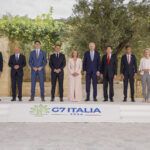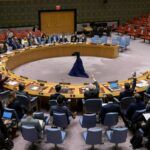In memoriam: Pief Panofsky (1919-2007)
By Sidney D. Drell | October 2, 2007
Pief’s humanity, integrity, and commitment to principles were the hallmark of his life, and earned him universal respect above and beyond the admiration for him as a physicist and creator of the Stanford Linear Accelerator Center (SLAC).
I first met Pief in 1951 when he arrived at Stanford University, where I was working temporarily as a physics instructor. Pief moved to Stanford because the University of California required its faculty and other employees to sign a loyalty oath to the U.S. Constitution. It was the heyday of security witch hunts and investigations into communist subversion by congressional un-American activity committees. This requirement to sign such a special loyalty oath affirming “lack of communist contamination,” as Pief called it, caused a major disruption at Berkeley. A number of faculty members quit, and others were fired for refusing to sign the oath. There was no question about Pief’s loyalty; he had security clearances to work on the atomic bomb at Los Alamos during World War II. He did reluctantly sign the oath, but then he resigned, saying the oath was wrong and the situation too intolerable for him. Incidentally, the courts later ruled that requiring that oath was illegal.
It was Stanford’s great fortune that Pief chose to accept a position as a physics professor. He subsequently assumed directorship of the High Energy Physics Lab, which went on to do great science. Pief was also popular for his excellent lectures, patience, and accessibility, creating the same open, collegial relationship with students that he nurtured for all of us at SLAC.
Pief could be very persuasive. When addressing an issue, he did his homework; those who dealt with him knew they were up against a powerful force of nature. This was true at SLAC on detailed technical issues such as alignment of the accelerator, as well as in his Washington activities–whether dealing with nuclear bomb testing or support for science. Pief was deeply engaged at all stages–frequently at 37,000 feet, en route to Washington, Moscow, Geneva, Beijing, or wherever.
During the Eisenhower administration, he headed the White House technical working group dealing with methods for detecting nuclear explosions in space. This was an early step to a treaty banning nuclear testing above ground or in the oceans, tests that would lead to environmental damage and radioactive fallout that threatened humans. The results of his study were presented by President Dwight D. Eisenhower in diplomatic negotiations with Russia in 1959, in which Pief participated as chairman of the U.S. team in one of the technical negotiations with Soviet counterparts.
Their agreement was the first step toward the signing of the Limited Test Ban Treaty in 1963, which restricted all nuclear testing to underground sites. He contributed much more work on testing limits for the next 35 years, leading up to the Comprehensive Test Ban Treaty, signed by the United States and ratified by a total of 140 countries, although not by the United States. Even though it’s not yet officially in force, all the nuclear powers (except North Korea, which tested last year) are complying with it.
Pief’s prominence and importance in trying to control the arms race and save the world from nuclear holocaust drew attention from Playboy in June 1977. “Dr. Panofsky may be the brightest man in the world,” the article noted. And later, “He is 5-feet, 2-inches tall, weighs 150 pounds, neither smokes nor drinks, and is manifestly, painfully indifferent to clothes. Not that he is a nudist; just that his mind is on higher things.” Playboy then went on to describe Pief’s other charms, one of them being that he built a straight 10,000-foot “long vacuum pipe that is housed in a heavy concrete casing some 25 feet underground that has no practical use whatsoever.” Playboy also called him “a key figure in the Strangelove” business. Finally, the magazine concluded, “He therefore has helped the government avoid potentially embarrassing crushing boo-boos.” I can personally vouch for the accuracy of that statement. I only wish that his views had been accepted and acted upon more frequently. We’d be in better shape today facing the dangers of nuclear weapons if they had been.
The diary of George Kistiakowsky, special assistant to President Eisenhower for science and technology from 1959 to 1961, described Pief as a persistent, committed fighter for the things he believed in. That was the period when the decision to build SLAC was being debated in the highest halls of government. It was opposed by strong forces in the East who didn’t fully appreciate the wonderful world west of the Hudson River. The great I. I. Rabi, among many others, strongly opposed constructing big accelerators in California and believed that we should pursue proton rather than electron accelerators because they reach higher energy. Some condemned SLAC as premature, unwise, and useless to high-energy physics.
Up against this situation and the fact that the chief advisory panel on high-energy physics for the Atomic Energy Commission (AEC) and the President’s Science Advisory Committee couldn’t reach a unanimous consensus, the fate of SLAC hung perilously in the balance. But Pief fought hard and with all of his strength. His credibility and the extraordinarily high respect he earned with President Eisenhower for his important contributions on nuclear weapon issues and peace were critical to Pief’s success in making SLAC a reality. I also have the impression that the victory was aided in part by a desire of some of our detractors to get Pief out of their hair by exiling him 3,000 miles away to California.
After Pief gained White House support for SLAC, his struggles were far from over–monumental political and self-imposed barriers of principle remained. One battle of principle, not widely known, Pief waged with Stanford’s strong support–including President Wally Sterling and David Packard, chairman of the Board of Trustees. They rejected AEC’s insistence for a requirement in SLAC’s contract that Pief describes best in his forthcoming book, Panofsky on Physics, Politics and Peace: Pief Remembers: “The AEC insisted on a provision that would require Stanford to undertake any work at SLAC, again ‘in the national interest,’ which the AEC deemed necessary: This provision was intended to compel the university to have SLAC undertake classified military work when demanded to do so by the AEC. I considered this to be unacceptable.”
He went on to tell the authorities that this would be an impossible condition for the university to accept. Even though he was warned that it would cost him the project, he and Stanford remained firm, and they prevailed. We all won by that display of courage, including other universities who had previously complied with such a directive, which was subsequently dropped.
Pief was awarded just about every conceivable honor that science and the U.S. government can give because of his wisdom, his devotion to science and peace, and his status as a national resource. It would be wrong to conclude that in spite of all of his achievements, the Nobel Prize eluded Pief. I would put it differently: Pief bypassed the Nobel Prize by his dedicated commitment to two personal crusades. The first was the creation and management of SLAC. The extraordinary achievements at the center during Pief’s leadership garnered three Nobel Prizes for five of our colleagues, events that brought him great pleasure. The second crusade was his deep patriotism and devotion to U.S. national security and world peace–an activity to which he devoted his life until his last day.
Together, we make the world safer.
The Bulletin elevates expert voices above the noise. But as an independent nonprofit organization, our operations depend on the support of readers like you. Help us continue to deliver quality journalism that holds leaders accountable. Your support of our work at any level is important. In return, we promise our coverage will be understandable, influential, vigilant, solution-oriented, and fair-minded. Together we can make a difference.
Topics: Opinion














